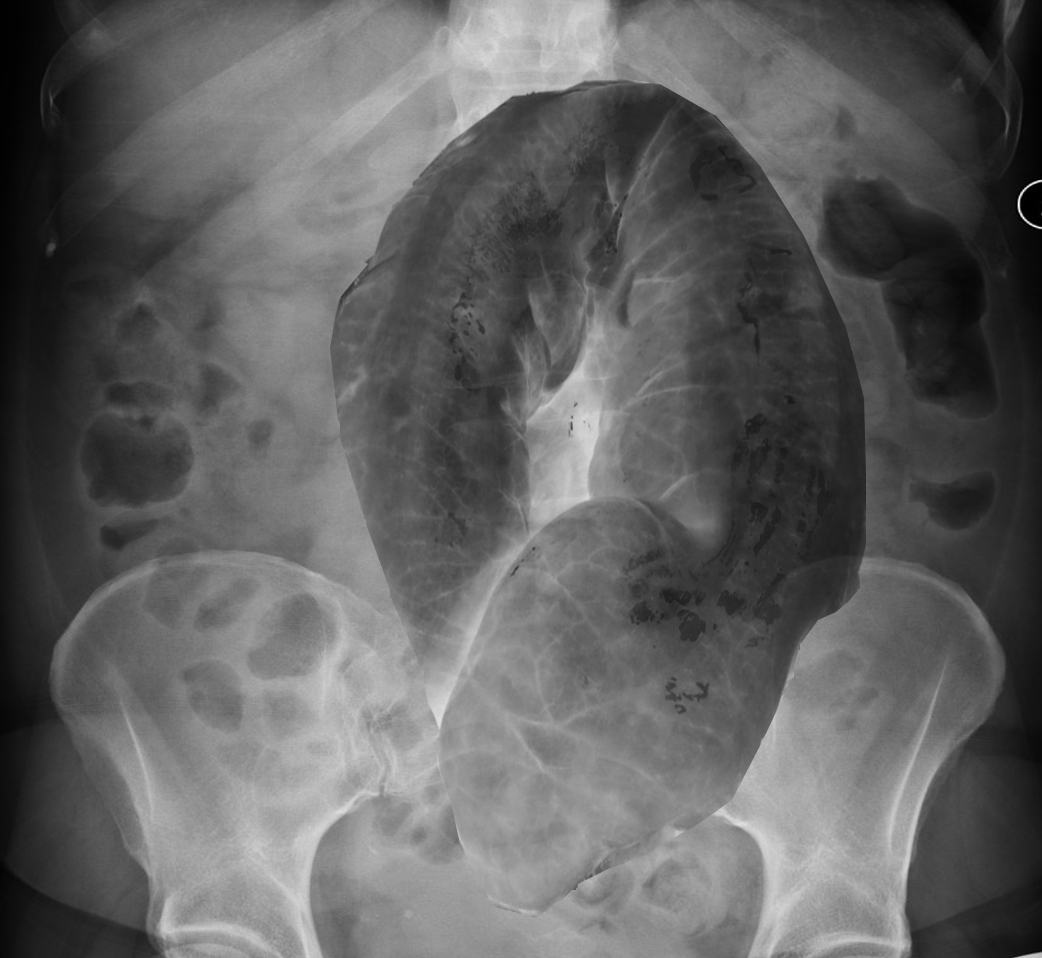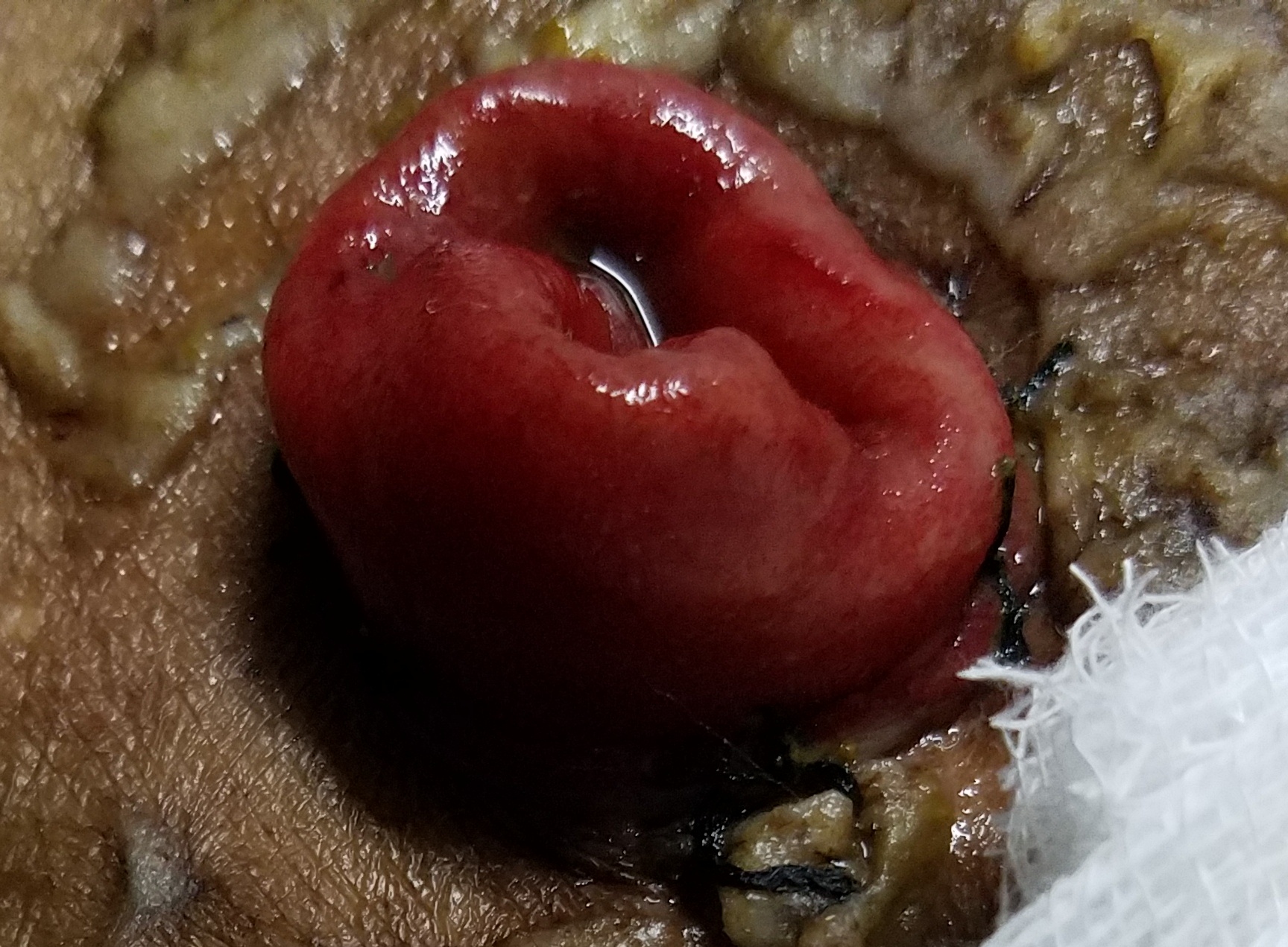Introduction
A volvulus is a twist of the intestine around the axis of its blood supply. In the case of a sigmoid volvulus, the twist occurs in the sigmoid mesentery at its base. Sigmoid volvulus is the most common type of volvulus of the colon. Less common are caecal volvulus and volvulus of the transverse colon. It presents most commonly in patients who are less mobile, bed bound and institutionalized, usually with a background of chronic constipation.[1][2][3][4][5]
Etiology
Register For Free And Read The Full Article
Search engine and full access to all medical articles
10 free questions in your specialty
Free CME/CE Activities
Free daily question in your email
Save favorite articles to your dashboard
Emails offering discounts
Learn more about a Subscription to StatPearls Point-of-Care
Etiology
In order for a volvulus to occur, the bowel needs to be able to twist around a narrow-based mesentery. This occurs mostly in less mobile patients with a history of chronic constipation, where the sigmoid colon becomes chronically distended and redundant.
Epidemiology
Sigmoid volvulus is more common in Africa, as the food intake is of high fiber and the base of the sigmoid mesentery in the African population is narrow compared with other ethnic groups, leading to an anatomical situation that makes the population more susceptible to developing a sigmoid volvulus.
Pathophysiology
Volvulus is a classical example of a large bowel closed loop obstruction. If inflow and outflow of the colon are both obstructed, the obstructed bowel will continue to distend, due to a large amount of gas forming bacteria trapped inside. This will eventually lead to a perforation of the obstructed segment.
While the colon is obstructed and distending, there is impaired blood supply, leading to ischemia, as well as bacterial translocation of the gut flora. Usually, the venous outflow is compromised first, increasing congestion even further, until arterial supply stops. The colonic mucosa is most susceptible to ischaemic insult, leading to an impaired barrier and translocation of bacteria, until the ischemia affects muscular and serosa, leading to necrosis and perforation.
Sigmoid volvulus can become a recurrent situation, and in those patients treated conservatively, the base of mesentery will eventually become fibrotic and the bowel chronically distended.
History and Physical
Patients presenting with volvulus are usually of an older age group with potential other comorbidities, often have reduced mobility or are bed bound and commonly get referred from residential and nursing homes. A history of chronic constipation is common. The symptoms usually leading to acute hospital admission are a loss of appetite and reduced oral intake, increasing abdominal distension, and cessation of bowel output. Patients complain of discomfort due to the significant distension, but are rarely in pain, unless ischemia and/or a perforation have occurred. They can, however, have respiratory compromise due to the splinting of the diaphragm that is a result of the colonic distension.
Patients may present with sigmoid volvulus as a recurrent problem if they have been treated with conservative measures in the past. A recurrent episode of volvulus needs to be taken a seriously as a first presentation and requires the same attention to history and physical examination as a patient presenting with volvulus for the first time.
Examination of the abdomen reveals significant distension, a generalized tympanitic percussion note and potentially guarding and rebound over areas of ischemia or impending perforation. If a perforation has already occurred, the patient will be grossly peritonitic. Digital rectal examination reveals an empty and often capacious rectum.
Evaluation
The patient should have the standard blood work (full blood count and renal function tests), to aid in resuscitation and assess the kidney function for a potential CT scan with contrast. Plain abdominal radiographs will show the classical coffee bean or kidney bean sign, and often dilatation of the proximal colon. Depending on the duration of symptoms, the proximal colon can decompress into the distal small bowel, as long as the ileocaecal valve is incompetent. CT scan shows the characteristic "whirl" appearance of the twisted mesentery, as well as the distended loop of sigmoid colon with an air-fluid level. Free air on either the abdominal radiograph or the CT scan indicates a more serious bowel perforation and requires immediate action.[6][7][8][9]
A CT scan is recommended to establish the diagnosis and distinguish the etiology from other causes of large bowel obstruction, such as a malignant tumor. This is especially the case if the patients present with symptoms for the first time and have not had any previous colonic investigations such as a colonoscopy.
Treatment / Management
Before any surgical intervention, the patient needs to be adequately resuscitated with intravenous fluids, and electrolyte imbalances should be corrected. A nasogastric tube can aid proximal decompression. Decompression of the sigmoid volvulus should be attempted with a soft rectal flatus tube by the bedside, ideally feeding the tube under direct vision through a rigid sigmoidoscope. Flexible Sigmoidoscopy with gentle insufflation is indicated if the bedside decompression fails or if there are concerns about the viability of the bowel wall, as the mucosa can be inspected during the sigmoidoscopy and areas of mucosal ischemia will become obvious.[10][11][12](A1)
Those patients who cannot be decompressed or who have progressed to compromised viability of the colon will need surgical intervention. The surgery of choice is a sigmoid colectomy with either a primary anastomosis or an end colostomy, depending on findings during the surgery and the individual patients’ physiological reserves.
A patient presenting with bowel perforation will require aggressive resuscitation and an immediate laparotomy to control the fecal contamination and remove the perforated segment of bowel.
Patients presenting with recurrent episodes of sigmoid volvulus that can be decompressed should have an informed discussion about the benefits and risks of an elective resection of the sigmoid to prevent further episodes of volvulus leading to emergency admission to hospital. In the elective situation, a sigmoid colectomy can usually be performed with a primary anastomosis instead of an end colostomy, unless the patient has significant comorbidities.
Differential Diagnosis
- Abdominal Aortic Aneurysm
- Acute Gastroenteritis
- Aortoenteric Fistula
- Appendicitis (Early)
- Bowel Obstruction
- Bowel Perforation
- Diabetic Ketoacidosis
- Gastroparesis
- Mesenteric Ischemia
- Sickle Cell Crisis
- Volvulus
Pearls and Other Issues
Bedside decompression with a flatus tube should only be carried out by experienced physicians, and under no circumstance against resistance, as there is a risk of inadvertent iatrogenic perforation. The safest method to decompress the sigmoid colon is under direct vision with rigid or flexible sigmoidoscopy.
A successful decompression will immediately result in the evacuation of liquid and gas per rectum with subsequent resolution of the abdominal distension, resulting in a soft abdomen.
This resolution can be documented on a repeat abdominal radiograph.
It is important to assess the patient for sustained resolution once the flatus tube has been removed and the patient is started on oral intake, to avoid the volvulus recur before the patient is even discharged.
Enhancing Healthcare Team Outcomes
The diagnosis and management of sigmoid volvulus is with an interprofessional team that consists of a surgeon gastroenterologist, primary care provider, nurse practitioner, and an internist. The initial treatment is decompression with a flexible endoscope but because of recurrence, surgery is recommended. Most of the patients are old and frail with several comorbidities. Hence, great caution should be used in recommending aggressive treatments. The outcomes for healthy patients after surgery are excellent. [13][14](Level V)
Media
(Click Image to Enlarge)
(Click Image to Enlarge)
References
Tejera Hernández AA, Betancort Rivera N, Pérez Alonso E, Hernández Hernández JR. Sigmoid volvulus due to Chagas disease. Emergencias : revista de la Sociedad Espanola de Medicina de Emergencias. 2018 Dic:30(6):437-438 [PubMed PMID: 30638352]
Sahu KK, Sherif AA, Lopez CA. Omega sign: Radiological appearance of sigmoid volvulus. Journal of medical imaging and radiation oncology. 2019 Feb:63(1):82-83. doi: 10.1111/1754-9485.12848. Epub 2019 Jan 10 [PubMed PMID: 30628190]
Ishibashi R, Niikura R, Obana N, Fukuda S, Tsuboi M, Aoki T, Yoshida S, Yamada A, Hirata Y, Koike K. Prediction of the Clinical Outcomes of Sigmoid Volvulus by Abdominal X-Ray: AXIS Classification System. Gastroenterology research and practice. 2018:2018():8493235. doi: 10.1155/2018/8493235. Epub 2018 Nov 15 [PubMed PMID: 30581464]
Level 2 (mid-level) evidenceAtamanalp SS, Comments on Contemporary Management of Sigmoid Volvulus. Journal of gastrointestinal surgery : official journal of the Society for Surgery of the Alimentary Tract. 2018 Nov 21; [PubMed PMID: 30465185]
Level 3 (low-level) evidenceBauman ZM, Evans CH. Volvulus. The Surgical clinics of North America. 2018 Oct:98(5):973-993. doi: 10.1016/j.suc.2018.06.005. Epub 2018 Jul 31 [PubMed PMID: 30243456]
Mba EL, Obiano SK, Mshelia NM. Compound volvulus: a case report and literature review. Journal of surgical case reports. 2018 Nov:2018(11):rjy311. doi: 10.1093/jscr/rjy311. Epub 2018 Nov 13 [PubMed PMID: 30443321]
Level 3 (low-level) evidenceCarmo L, Amaral M, Trindade E, Henriques-Coelho T, Pinho-Sousa J. Sigmoid Volvulus in Children: Diagnosis and Therapeutic Challenge. GE Portuguese journal of gastroenterology. 2018 Sep:25(5):264-267. doi: 10.1159/000486242. Epub 2018 Feb 6 [PubMed PMID: 30320166]
Motsumi MJ, Tlhomelang O. Synchronous volvulus of the sigmoid and transverse colon in a 26-year-old male. Journal of surgical case reports. 2018 Nov:2018(11):rjy295. doi: 10.1093/jscr/rjy295. Epub 2018 Nov 13 [PubMed PMID: 30443313]
Level 3 (low-level) evidenceXiang H, Han J, Ridley WE, Ridley LJ. Horseshoe sign: Sigmoid volvulus. Journal of medical imaging and radiation oncology. 2018 Oct:62 Suppl 1():85-86. doi: 10.1111/1754-9485.33_12784. Epub [PubMed PMID: 30309120]
Frank L, Moran A, Beaton C. Use of percutaneous endoscopic colostomy (PEC) to treat sigmoid volvulus: a systematic review. Endoscopy international open. 2016 Jul:4(7):E737-41. doi: 10.1055/s-0042-106957. Epub 2016 Jun 29 [PubMed PMID: 27556086]
Level 1 (high-level) evidenceEchenique Elizondo M, Amondaraín Arratíbel JA. Colonic volvulus. Revista espanola de enfermedades digestivas. 2002 Apr:94(4):201-10 [PubMed PMID: 12185931]
Garfinkle R, Morin N, Ghitulescu G, Vasilevsky CA, Boutros M. From Endoscopic Detorsion to Sigmoid Colectomy-The Art of Managing Patients with Sigmoid Volvulus: A Survey of the Members of the American Society of Colon and Rectal Surgeons. The American surgeon. 2018 Sep 1:84(9):1518-1525 [PubMed PMID: 30268187]
Level 3 (low-level) evidenceQuénéhervé L, Dagouat C, Le Rhun M, Perez-Cuadrado Robles E, Duchalais E, Bruley des Varannes S, Touchefeu Y, Chapelle N, Coron E. Outcomes of first-line endoscopic management for patients with sigmoid volvulus. Digestive and liver disease : official journal of the Italian Society of Gastroenterology and the Italian Association for the Study of the Liver. 2019 Mar:51(3):386-390. doi: 10.1016/j.dld.2018.10.003. Epub 2018 Oct 11 [PubMed PMID: 30377062]
Dolejs SC, Guzman MJ, Fajardo AD, Holcomb BK, Robb BW, Waters JA. Contemporary Management of Sigmoid Volvulus. Journal of gastrointestinal surgery : official journal of the Society for Surgery of the Alimentary Tract. 2018 Aug:22(8):1404-1411. doi: 10.1007/s11605-018-3747-4. Epub 2018 Mar 22 [PubMed PMID: 29569006]


